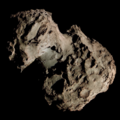 Hubble Space Telescope image of 354P/LINEAR with dusty impact debris on 2 February 2010 | |
| Discovery [1] | |
|---|---|
| Discovered by | LINEAR (704) |
| Discovery date | 6 January 2010 |
| Designations | |
| Orbital characteristics [3] | |
| Epoch 13 October 2010 (JD 2455482.5) | |
| Aphelion | 2.58 AU (Q) |
| Perihelion | 2.01 AU (q) |
| 2.29 AU (a) | |
| Eccentricity | 0.1246 |
| 3.47 yr | |
| 88.9° (M) | |
| Inclination | 5.25° |
| 320° | |
| 2023-Oct-13 [4] | |
| 133° | |
| Physical characteristics | |
| Dimensions | 172.4 × 88.8 m [5] |
| 123.8+33.6 −18.4 m [5] | |
| 11.36±0.02 h | |
| Albedo | unknown |
| ~18-20 [1] | |
| 21.3±0.6 [6] | |
354P/LINEAR, provisionally designated P/2010 A2 (LINEAR), is a small main-belt asteroid that was impacted by another asteroid sometime before 2010. It was discovered by the Lincoln Near-Earth Asteroid Research (LINEAR) at Socorro, New Mexico on 6 January 2010. The asteroid possesses a dusty, X-shaped, comet-like debris trail that has remained nearly a decade since impact. [5] This was the first time a small-body collision had been observed; since then, minor planet 596 Scheila has also been seen to undergo a collision, in late 2010. The tail is created by millimeter-sized particles being pushed back by solar radiation pressure. [7] [8]




